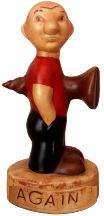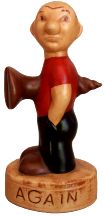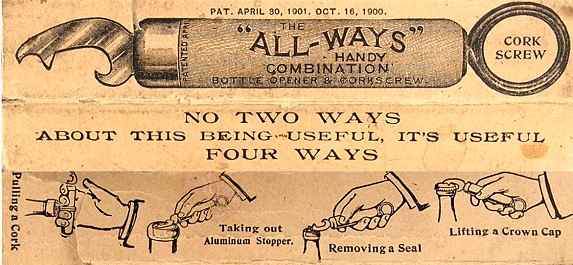 |
 The Virtual Corkscrew Museum's Weekly Newspaper |
 |
 |
 The Virtual Corkscrew Museum's Weekly Newspaper |
 |
|
Sunday, December 2, 2007 |
Number 492 |
The Stephens "All-Ways" Opener
by Bob Roger
Figure 1. The All-Ways Opener
Have you been looking for a patent for the odd-shaped blade on the end of the "All-Ways" tool shown in Figure 1? You may think you know because of the patent numbers on the tool, but they are not the whole story. But first, a quick glance at a few related bottle closures.
William Painter had many inventions related to bottle stoppers. His August 11, 1885 patent (#324,040) had a loop in it to enable it to be lifted out. There were many earlier patents for corks or stoppers containing some form of loop for pulling them, some appearing as early as 1868. Fred O'Leary's book contains many of them in his section on Related Patents at the back of the book. Painter's August, 1885 stopper is shown in Figure 2.
Fig. 2. Patent 324,040
Fig. 3. Painter Crown Cap
On February 2, 1892 Painter received three patents related to his 'crown cap' sealers, numbers 468,226, 468,258, and 468,259. Figure 3 shows one of his crown caps, and Figure 4 shows another.
Fig. 4 Another of Painter's 1892 Crown Caps
Fig. 5. Painter's Opener
Note that the cap in Figure 4 also contains a loop, and the drawing also shows a hooked tool for lifting it. On February 6, 1894 Painter received patent number 514,200 for a tool to lift his crimped crown caps, and on the opposite end was his hook for lifting those containing a loop. That patent is shown in Figure 5.
Now, back to the All-Ways opener. Figure 6 shows an illustration from Ron MacLean's publication Common Corkscrews-III printed in 1990. The "All-Ways" tool was often marked with two patent numbers, Clough's October 16, 1900 patent (#659,649) for the corkscrew and Baseler's April 30, 1901 patent (#673,153) for the crown cap puncture point (the intermediate point) on the extractor blade at the other end.
The extractor blade on the All-Ways performs three functions - it lifts crown caps, punctures the cap so that it cannot be reused (the intermediate point), and serves as a hook (the tip) for removing a bottle seal that has a loop in it (often termed a "patent" stopper). Baseler's 1901 patent, shown in Figure 7, was for a cap puncturing function and was assigned to the Augustus W. Stephens Mfg. Company of Cambridgeport, Massachusetts who manufactured the All-Ways tool.

Fig. 6. All-Ways Opener
Fig. 7. Baseler's Cap Puncturer
But that is not the end of the story. Baseler did not invent the hook at the end that is used to lift "patent" stoppers, and he did not invent the thin-bladed crown cap lifter on the tool. So another patent had to be involved in the All-Ways although no other patent is acknowledged in its markings. After considerable patent searching, I believe that the honor for these last two functions goes to Saville Johnston of Boston who was issued patent number 631,872 on August 29, 1899. His drawing is shown in Figure 8.
Fig. 8. Johnston's Patent
There were several patents for crown cap lifters before Johnston's. For example, Painter himself had the one in Figure 5, and both Walker and Williamson of corkscrew fame had their cap lifter patents. But none of the earlier patents used a thin hooked blade to do the lifting. Johnston was the first to do that, and he also included an end hook for lifting stoppers with loops. He also sharpened the inside edge of the longer hooked arm so that it could be used to cut the wires that were often used to hold a cork in place. This wire cutting function was not incorporated in the All-Ways. Johnston's patent drawing shows his blade incorporated into a jack knife, an application that was popular for many years.
The All-Ways advertisement in Figure 6 also shows it being used to lift aluminum stoppers. Although the drawing is not detailed enough to identify the stopper type, it may have been referring to one of Painter's many stoppers or seals such as that shown in Figure 4 or his October 21, 1890 patent (# 438,709) shown in Figure 9. In the latter case, the edge of the blade could be laid under the lip of the stud in the middle of the stopper, which could then be lifted.
Fig. 9. Painter's 1890 Stopper
Editor's Note: See the February 11, 2007 issue of The Weekly Screw for more on the All-Ways and Augustus Stephens.
Editor's Note: Bob Roger is a collector of corkscrews and a wide variety of tools. He is the author of A Guide to Gimlets published in 2003 and Patented Ice Reducing Tools: An Identification Guide for Hand-Held Picks, Chippers, Crushers, and Shaves published in 2007.
Corked - Uncorked
This Corked - Uncorked print is an exhibit at the Furniture Exhibition Building (location not indicated). It is a 1894 print copyrighted by Oscar Onken & Co., Art Publishers, Cincinnati, Ohio. There is a corkscrew on the table.
Game of Goblins
Last week a partial deck of cards called the Game of Goblins was offered for sale on eBay. The cards were published by L. Prang & Co., 159 Washington Street, Boston, Massachusetts. The seller dated the deck at c.1865. A goblin is pulling a cork from a bottle in the card second from bottom right.
Exposition Follow-up
Last week's issue featured a story on the 1889 Exposition Universelle in Paris. Reader Hans Turler wrote "The French Club CFTB had the meeting 2000 in Paris. As a gift we made a reproduction of a 1889 Exposition Universelle corkscrew."
More Israeli Corkscrew
From the collection of Antonio Lopez
Spotted on eBay
These have been added to the September 23, 2007 issue on Israeli Corkscrews to bring the issue up to date.
|
©2007 Don Bull, Editor |